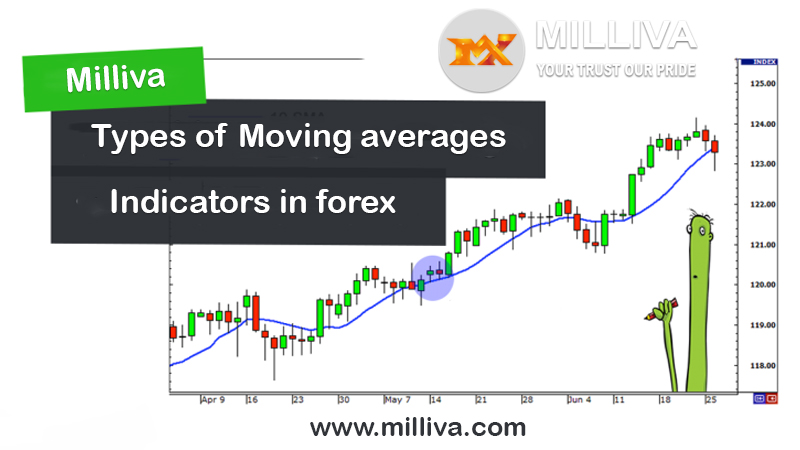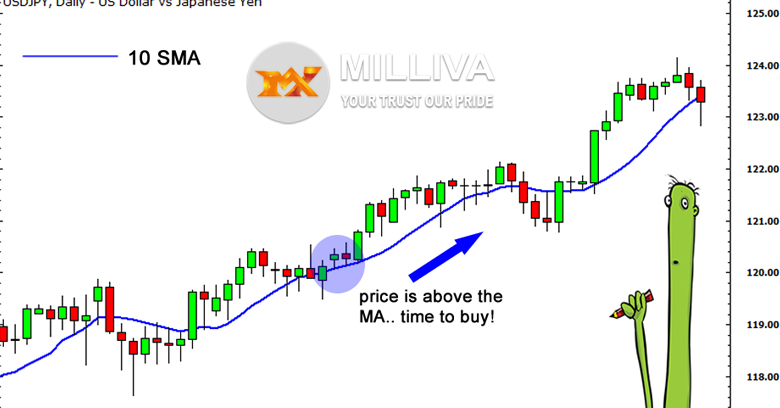Moving Average Indicator Types in Forex

![]()
Simple Moving Average Indicator are technical indicators that depict the average price movement over time. They frequently used to identify trends, detect trend reversals, and generate trading signals. Moving average come in a variety of shapes and sizes.
They each draw a line on a chart to indicate the direction in which a price is moving. Learn about the many sorts of average used by traders and what they mean when it comes to a price.
An analyst uses the moving average to determine support and resistance by analyzing the asset’s price movements. This indicator depicts a security’s historical price movement, which traders use to forecast the asset price’s future direction.
It is a lagging indicator because it produces a signal or shows the price direction of any stock by trailing the price movement of any underlying asset.
Simple Moving Average Indicator:
The SMA stands for Simple Moving Average Indicator. Is the simplest moving average, which is calculate by multiplying the number of time periods by the sum of the most recent data points?
Traders use the Simple Moving Average Indicator is to give signals for when to enter or quit a stock. Because it is dependent on prior price data for a certain time, an Simple Moving Average Indicator is a lagging indicator. It may compute for many sorts of prices such as high, low, open, and close.
This indicator used by traders to determine buy and sell signals for stocks, as well as to identify support and resistance zones. A stock trader, for example, could seek to determine a stock’s simple moving average by taking its closing price over the previous five days.
SMA =( A1+A2+…+An) /n
where:
An=the price of an asset at period
n=the number of total periods
The closing prices for the last five days are as follows: Rs.23, Rs.23.40, Rs.23.20, Rs.24, and Rs.25.50.
Simple Moving Average Indicator will be calculated as below:
SMA = (Rs.23 + Rs.23.40 + Rs.23.20 + Rs.24 + Rs.25.50) / 5
SMA = Rs.23.82

Exponential Moving Average (EMA):
The other form of moving average is the exponential moving average (EMA), which provides greater weight to recent price points and makes it more sensitive to current data points. When compared to the SMA, the EMA is more sensitive to recent price movements since it gives equal weight to all price changes in a particular time.
Calculating EMA, Three Stages to Follow:
To begin, we must compute the simple moving average for the given time period.
Current EMA is calculated by taking the duration from starting EMA to the most recent time period and multiplying it by the price, multiplier, and the prior period’s EMA value. The formula is as follows:
EMA = (K x (C – P)) + P
Where:
C = Current Price
P = Previous periods EMA (A SMA is used for the first periods calculations)
K = Exponential smoothing constant
Weighted Moving Average (WMA):
Another sort of moving average that traders use to determine trade direction and buy or sell decisions is the WMA.
It is calculated by multiplying a weighting factor by each point in the data set. The weighted average is used by traders to generate trading signals. When prices are above the weighted moving average, for example, it indicates that the trend is up. However, if the prices are lower than the weighted moving average, the trend is down.
WMA = (P1 * 5) + (P2 * 4) + (P3 * 3) + (P4 * 2) + (P5 * 1) / (5 + 4+ 3 + 2 + 1)
Where:
P1 = current price
P2 = price one bar ago, etc.…
Double Exponential Moving Average (DEMA):
DEMA is a better form of EMA since it gives the most recent data points greater weight. It has less latency and is more sensitive, making it easier for short-term traders to identify trend reversals.
The blue line represents a standard moving average, the purple line represents an exponential moving average (EMA), and the yellow line represents a dynamic moving average (DEMA). We can see from the chart above that the DEMA is the one that is closest to the price points and has the fewest variations.
Because the DEMA line most closely resembles stock prices, it is the most vulnerable to stock volatility. Volatility changes are strong predictors of a trend reversal and, as a result, stock transactions.
DEMA=2×EMAN− EMA of EMAN
where:
N=Look-back period
The Triple Exponential Moving Average (TEMA):
TEMA makes EMAs more sensitive to pricing by reducing their latency. Patrick Mulloy established the Triple Exponential Moving Average (TEMA) after the Double Exponential Moving Average (DEMA) was introduced in 1994. (TEMA). TEMA minimizes the lag difference between distinct EMAs in the same way that DEMA does.
TEMA’s formula includes a triple-smoothed EMA in addition to the single and double-smoothed EMAs used in DEMA’s formula. As a result, the moving average produced by this indicator utilizing these three EMAs is much closer to the price bars than DEMA.
Triple Exponential Moving Average (TEMA) = (3∗EMA1) − (3∗EMA2) +EMA3
Where:
EMA1=Exponential Moving Average (EMA)
EMA2=EMA of EMA1
EMA3=EMA of EMA2
Linear Regression (or) Least square Moving Average:
The least-squares moving average (LSMA) produces the least-squares regression line for previous time periods, resulting in future forecasts for the present period.
The indicator aids in determining what may occur if the regression line is maintained. The indicator is based on the sum of least squares approach for determining the best straight line to fit data for a certain time.
The formula for calculating the line of best fit is
b = ( nΣxy – ΣxΣy ) / ( nΣx² – (Σx)² )
a = ( Σy – bΣx ) / n

Visit us : www.milliva.com





